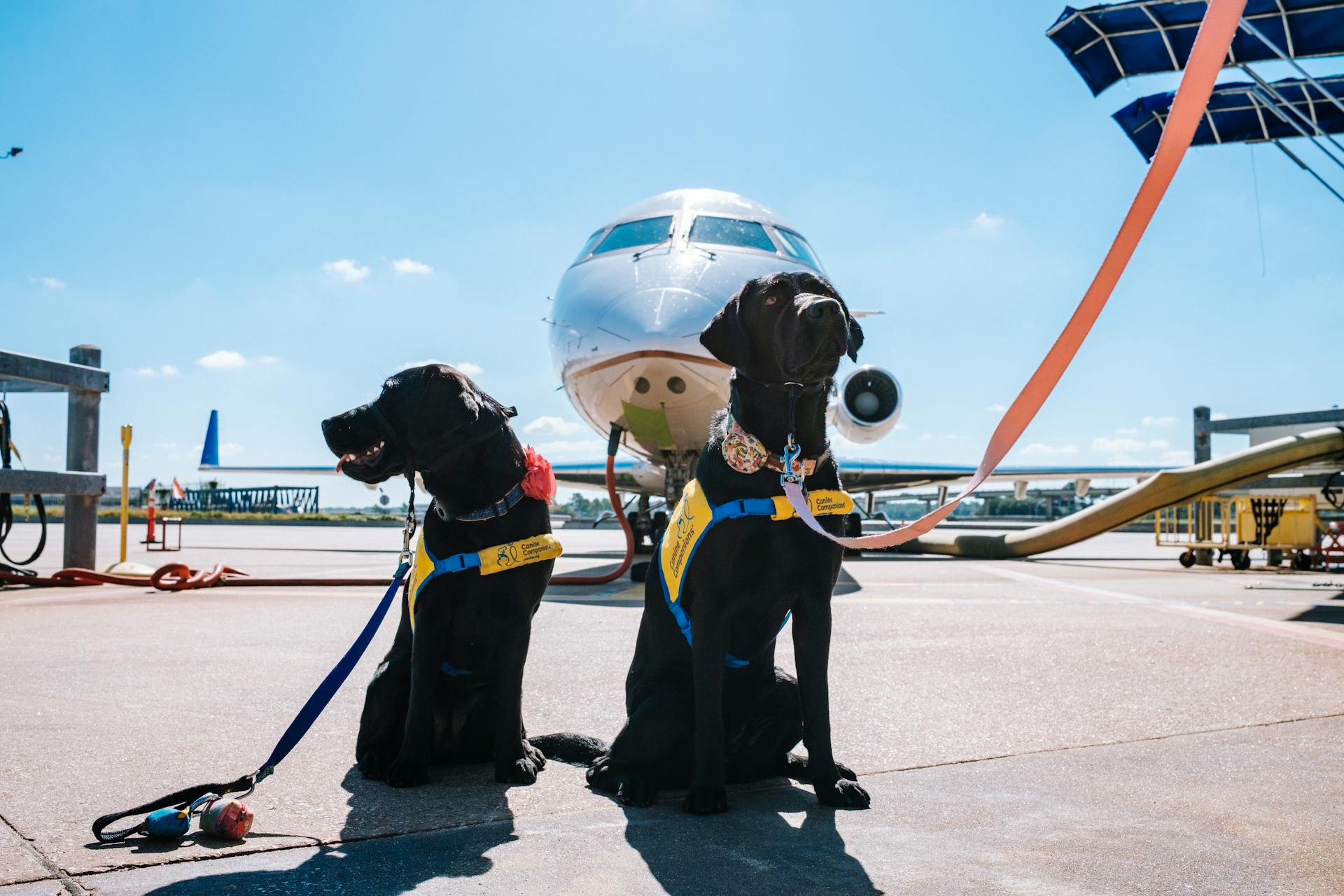
If you're considering training a cardiac alert dog, it's essential to understand the process and what to expect. Cardiac alert dogs are specifically trained to detect changes in their owner's heart rate and alert them to potential cardiac issues.
The first step in training a cardiac alert dog is to find a reputable breeder or rescue organization that specializes in training dogs for medical alert purposes. Research the organization's experience and success rate with cardiac alert dog training.
For another approach, see: How Do Service Dogs Know When to Alert
Cardiac Alert Dog Training
To become a cardiac alert dog, a dog must possess certain behavioral features such as being trainable, intelligent, easy-going, and having a strong bond with their handler. They also need to have a calm and stable personality, and some tasks require physical strength and robust bone structure.
Not every dog is suitable for work as a cardiac alert dog, and they must be able to sense heart rate or blood pressure changes. This ability can be enhanced through training, but it's essential to start with a dog that already has this innate ability.
The swab technique can be used to train a cardiac alert dog to notify their handler about oncoming events through a signal like barking or pawing. This process requires a lot of practice and positive reinforcement when the dog performs the task correctly.
What's Included?
A cardiac alert dog is trained to recognize early signs of a cardiac event and alert their handler to take preventive measures. These dogs can sense changes in heart rate and blood pressure.
They're equipped to provide physical support, offering balance and stability to handlers who may feel dizzy or weak. This can be a huge help for people with heart conditions.
Cardiac alert dogs are also trained to comforting and reduce stress, providing emotional support and companionship. This can contribute to overall heart health and well-being.
Their primary role is to monitor their handler's physical state and provide alerts to changes that may indicate a heart problem. They can sense changes in heart rate and alert their handler to take medication or seek medical help.
In an emergency, a cardiac alert dog can perform tasks such as fetching medication or finding another person to help. They can even activate an emergency alert system if the handler is incapacitated.
These dogs are trained to respond to the handler's needs after a cardiac event has occurred, providing comfort and support. They can lay down with their handler and help them feel more secure.
If this caught your attention, see: Financial Help for Service Dogs
Training a Dog as a Service Animal
Training a dog as a service animal requires careful consideration and a significant investment of time and effort. Not every dog is suitable for this work, especially as a medical alert dog, and must possess certain behavioral features like being trainable, intelligent, and having a calm and stable personality.
A long-nosed breed is more effective in its work as a cardiac or alert service animal. Strong obedience skills and good manners while in public are mandatory for every service dog.
The swab technique can be used for cardiac service dog training, which involves training the dog to notify you about oncoming events through a signal like barking, pawing, or nudging. This process requires a lot of practice and positive reinforcement.
A minimum of 120 training hours is required, with 30 hours spent in public, and the training process may take up to one to two years or more until the dog is fully trained as a cardiac service dog.
Additional reading: Assistance Animal Certification
Dogs
Cardiac service dogs can be trained to perform a variety of tasks, including alerting to heart rate changes and fetching medication. Their primary role is to monitor their handler's physical state and provide alerts to changes that may indicate a heart problem.
Some breeds are deemed more suitable as cardiac service dogs, such as Retrievers, German Shepherds, and Poodles, due to their friendly, disciplined, and intelligent nature. These breeds often have large noses, which can be beneficial for detecting changes in their handler's physical state.
Cardiac service dogs can be trained to perform tasks like opening doors and calling 911 in case of an emergency. They can also provide emotional support and comfort to their handlers, helping them feel more independent and safe.
The temperament of the individual dog is crucial when it comes to a service animal, and careful assessment is necessary to ensure the dog is a good fit for the handler. This involves choosing a reputable organization and committing to the ongoing care and training of the dog.
Additional reading: Tasks for Ptsd Service Dogs
Understanding Cardiac Alert Dogs
Cardiac alert dogs are trained to monitor their handler's physical state and provide alerts to changes that may indicate a heart problem. They can sense changes in the handler's heart rate and alert them to take medication or seek medical help.
These dogs are not the same as cardiac response dogs, which are trained to respond to the handler's needs after a heart problem has occurred. Cardiac response dogs can perform tasks like retrieving medication, calling 911, and laying down with their handler to comfort them.
To become a cardiac alert dog, a dog must possess certain behavioral features like being trainable, intelligent, easy-going, and having a strong bond with their handler. They should also have a calm and stable personality.
Not every dog is suitable for work as a cardiac alert dog, especially those without a strong obedience background and good manners in public. Strong obedience skills and showing good manners while in public is mandatory for every service dog.
Discover more: Conditioned Emotional Response Dog Training
The swab technique can be used for cardiac service dog training, where a dog is trained to notify their handler about oncoming heart problems through a signal like barking, pawing, or nudging. This process requires a lot of practice and positive reinforcement.
A dog should already possess the innate ability to sense heart rate or blood pressure changes to become a cardiac alert dog. This ability can be enhanced, and the dog can be trained to respond properly, but it's not something that can be expected of any dog.
For your interest: Can You Train Chihuahuas
Finding Your Dog
Cardiac service dogs are trained to be by your side at all times, so it's essential to know how to find your dog in case of an emergency.
Their keen sense of smell and ability to detect subtle changes in your physical state make them invaluable companions.
These dogs are trained to alert you to changes in your heart rate, which can be a lifesaver.
In the event of a medical emergency, your dog can fetch medication or medical devices to help you.
With their keen instincts, they can even find another person or activate an emergency alert system if you're incapacitated.
Their calm and comforting presence can be a great source of comfort during a medical crisis.
You might enjoy: Medical Dog Training
Frequently Asked Questions
What is the best breed for a cardiac alert dog?
The Labrador Retriever is a popular breed for cardiac alert dogs due to its friendly temperament and people-oriented nature. This breed excels as a service dog, making it a top choice for those in need of a cardiac alert companion.
Sources
- https://www.servicedogtrainingschool.org/blog/cardiac-alert-dog-training
- https://www.servicedogtrainingschool.org/blog/cardiac-service-dogs
- https://www.servicedogcertifications.org/can-you-get-a-service-dog-for-a-heart-condition/
- https://uksupportdog.com/cardiac-alert-service-dog
- https://www.azgoldensllc.com/ft-medical-alert
Featured Images: pexels.com

